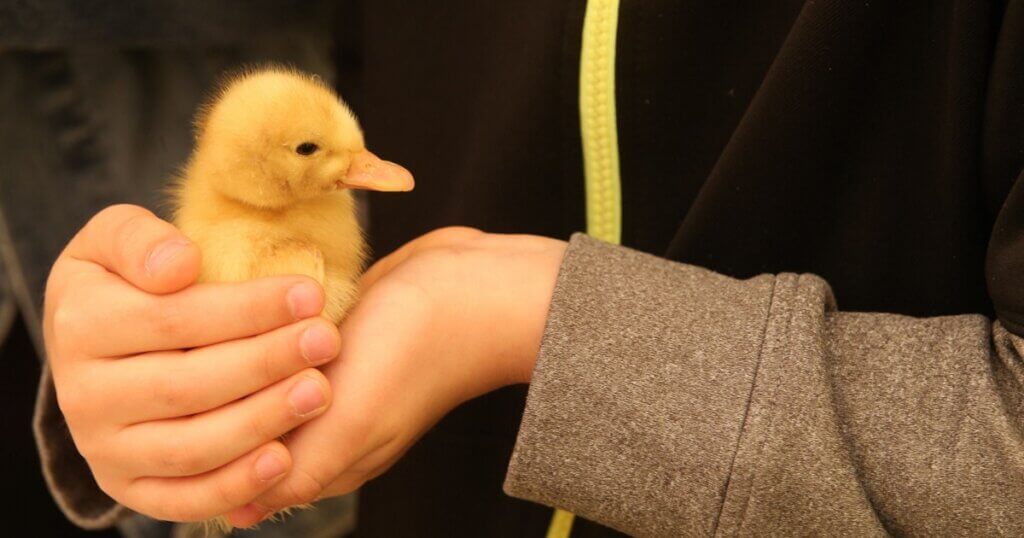Purdue Agriculture experts suggest thinking twice before purchasing Easter pets
Dating back centuries as a sign of fertility and new life, chicks and rabbits have been identified with Easter and spring décor, making their seasonal arrival in most farm supply stores a tempting purchase.
These pets, however, come with specific needs to be considered before heading to the check out, according to Emily Luc, Purdue Extension agriculture and natural resources educator, and Marisa Erasmus, associate professor animal sciences at Purdue University.
 A duckling is held by a Purdue Spring Fest 2019 attendee.
A duckling is held by a Purdue Spring Fest 2019 attendee. Before bringing any birds home, checking your local zoning ordinances is critical. Many Indiana cities and towns do not permit backyard poultry, Luc said. While some larger cities do allow for hobby chickens, many have a limit on both hens and roosters, with specific confinement clauses for roosters included.
Chickens are social birds, meaning your flock should consist of at least three chickens, Luc said. Aside from the ability to socialize, having more chicks will also increase their ability to keep warm, which is crucial for proper growth and survival.
Before purchasing chicks or ducklings, Luc said you should purchase a proper habitat ready for immediate transfer upon leaving the farm store. A brooder, an enclosed structure used to raise young poultry, will be needed and should include an infrared heat lamp with a hood over it to direct heat toward the floor. A mesh ring goes over the brooder to keep the chicks confined to an area near the heat source.
“The ideal temperature range inside the brooder is 90-95 degrees for the first week of the chick’s life. Chicks are typically only a day old when you’re purchasing them,” Luc said.
Bedding should be evenly distributed on the floor of the brooder to absorb moisture, with slick printed newspaper, cardboard or plastic being avoided as creating a slippery surface can lead to leg damage, Luc said. Giving the chicks and ducklings enough room to eat and drink water at the same time will also create a comfortable living environment, while immediately showing them where the water source is located is important, according to Erasmus.
“Ensuring the chicks and ducks drink water immediately after you bring them home is important,” Erasmus said. “To teach them where the water is in the brooder, you could gently dip their beaks in the water source. Place feed in a shallow dish to make it easy for them to find food.”
While ducks are waterfowl, Erasmus said it is not a good idea to give ducklings swimming water until they are at least four to five weeks old, because their feathers are not yet waterproof, posing a risk for drowning.
Feeding chicks and ducklings a proper starter diet is important for healthy growth, Erasmus said, which should be fed to them until they reach between six to eight weeks of age.
Those unfamiliar with raising chickens will be surprised at how quickly the 1.4-ounce fluffy babies will grow into six to eight pound birds within 22 weeks.
“Chickens are able to produce their own eggs at just 18-weeks-old,” Erasmus said. “That cute little yellow chick won’t last for long, so that needs to be kept in mind, too. Within four weeks they can have their own full set of feathers. Before buying chicks, especially for someone else, it is important to think about where the animals will end up after Easter. Chickens can live for several years if properly cared for, so it is important to consider the long-term implications before buying chicks or ducklings. Ducklings also grow up to be adult ducks, and domesticated ducks cannot fly, so they are unlikely to survive on their own in the wild and need to be properly cared for.”
For rabbits, their ideal environment temperature is between 45-70 degrees, Luc said, and can be housed indoors or outdoors. Should a pet owner decide to house their rabbit outdoors, however, consideration should be taken for protection from the weather as well as from predators.
“The size of the cage is determined by the size and weight of the rabbit,” Luc said. “For example, if the rabbit weighs between 4.4 and 8.8 pounds, the minimum space requirement is three square feet. The cage height has a minimum requirement of 16 inches which allows the rabbits to erect their ears without touching the top of the cage.”





